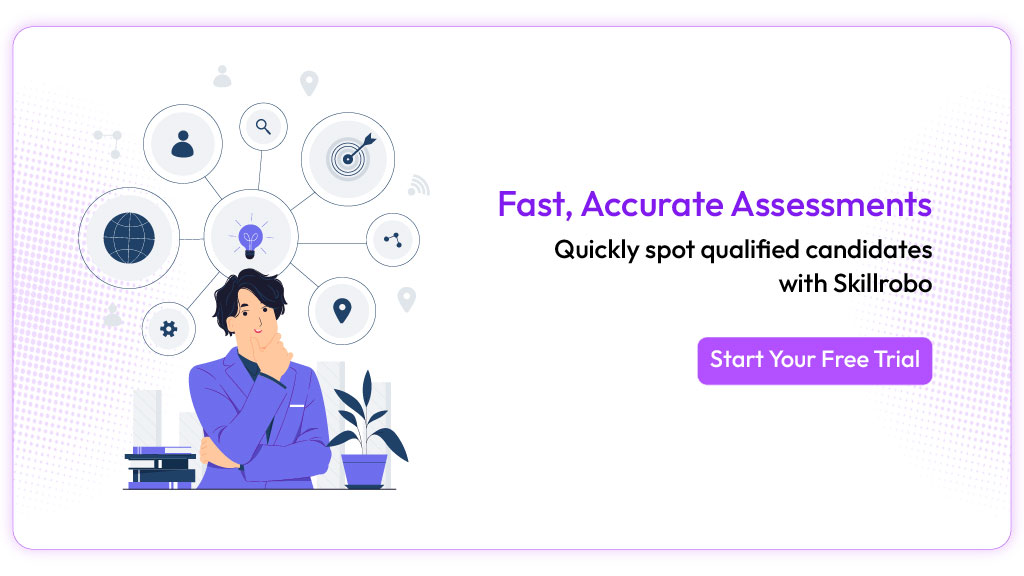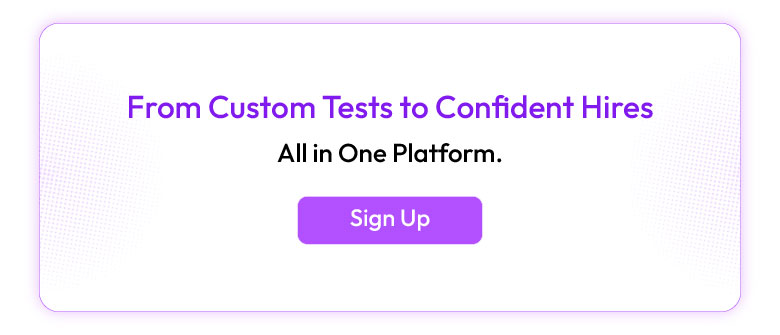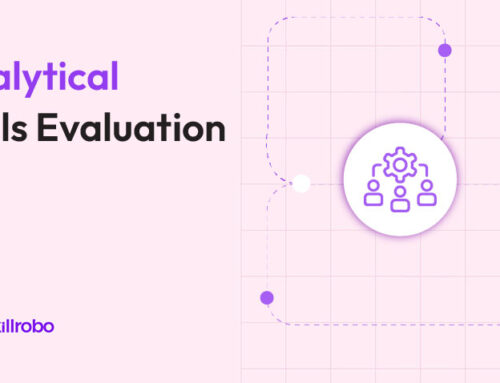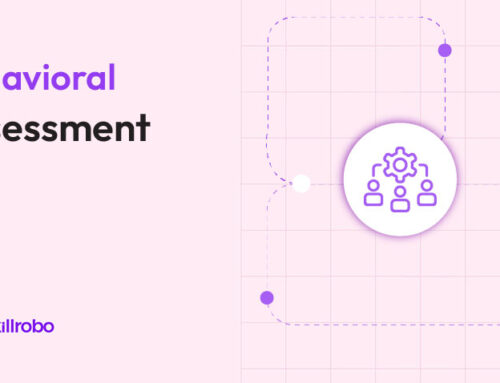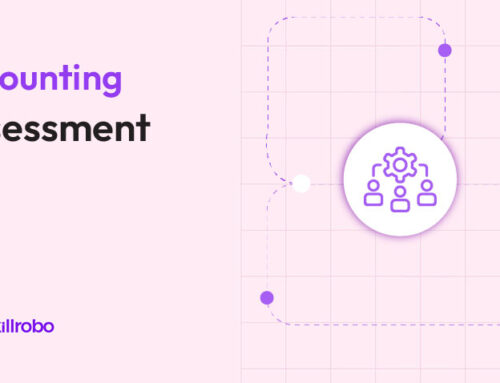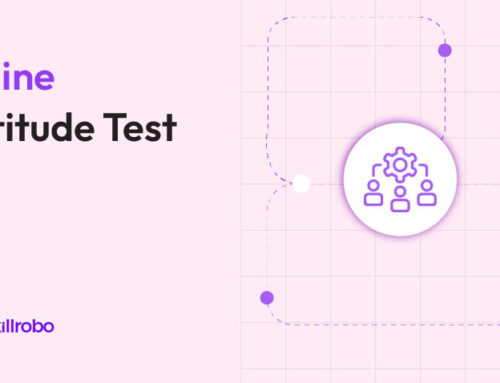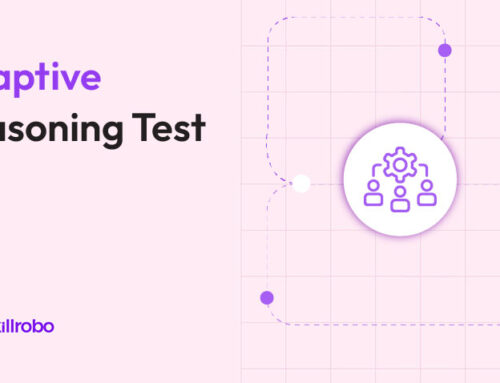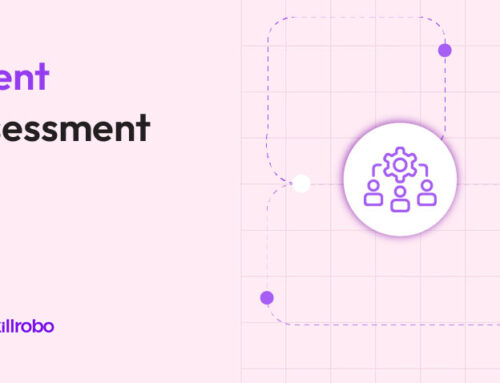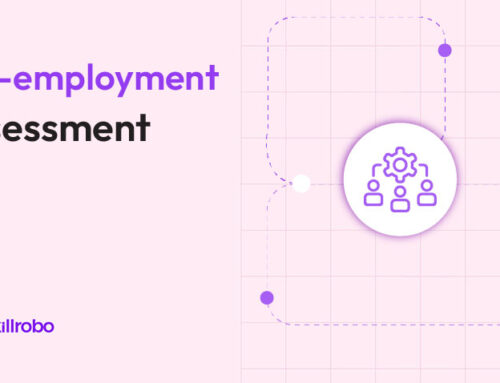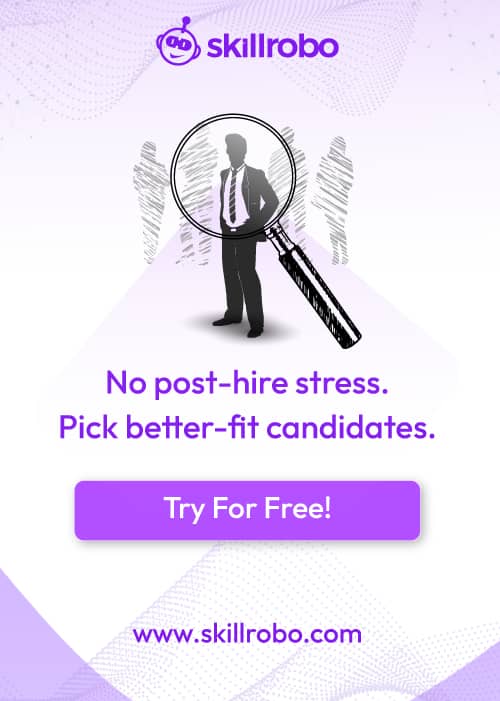Table of Contents
Related articles
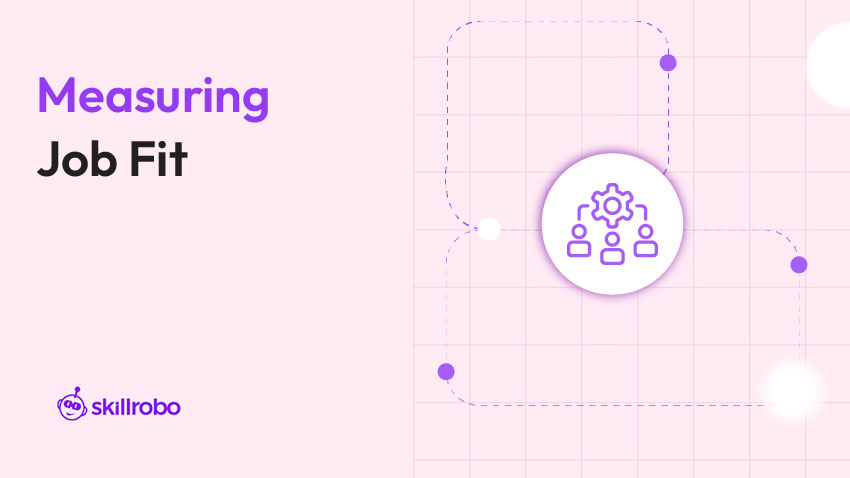
Key Takeaways
- Job fit assessments evaluate how well a candidate’s skills, values, and personality align with role expectations.
- Online talent assessments help HR teams move beyond resumes to predict real-world job performance.
- Cognitive, behavioral, and skill-based tests provide a well-rounded view of candidate-job compatibility.
- A structured approach to measuring job fit leads to better hiring decisions, reduced turnover, and stronger teams.
Why Job Fit Matters More Than Ever
Hiring success isn’t just about finding the most qualified candidate—it’s about finding the right match for the role and the organization. A person may have the technical skills, but if they don’t align with the role’s demands or the team culture, performance and retention suffer. Job fit assessments focus on how candidates behave, think, and interact—not just what they’ve done in the past. These insights help HR teams predict future performance, engagement, and job satisfaction, giving hiring decisions greater accuracy and long-term value. In this blog, we explore how to measure job fit with online talent assessments.
What Online Talent Assessments Can Measure
Online assessments are far more than screening tools—they are strategic instruments that provide structured, unbiased, and measurable insights into how well a candidate fits a role. Unlike resumes or interviews, which often rely on subjective interpretation, talent assessments offer data-driven validation of a candidate’s potential and alignment with job expectations.
Here’s what a comprehensive assessment can measure:
1. Cognitive Aptitude
Tests logical reasoning, learning agility, and problem-solving ability. These are especially important in roles that require analysis, fast thinking, or adaptability, such as data analysis, software development, or business strategy. Tools like Skillrobo help evaluate cognitive capabilities in technical roles through logic-based and quantitative test formats.
2. Personality Traits
Analyzes temperament, work ethic, stress response, and motivation. These traits impact how a candidate fits into a team and adapts to a company’s culture. Whether it’s leadership potential or introversion in a client-facing role, personality data informs smarter hiring.
3. Soft Skills
Measures collaboration, empathy, conflict resolution, and communication skills essential in almost every modern role. Especially in remote or hybrid teams, soft skills drive team cohesion and productivity. For example, Skillrobo offers communication skills assessments that evaluate both clarity and responsiveness.
4. Role-Specific Knowledge
Evaluates hands-on capability in technical or functional areas like coding, marketing analytics, accounting, or customer support. These assessments directly simulate job tasks or ask domain-specific questions to confirm practical understanding through pre-employment aptitude test formats customized to real-world scenarios.
5. Situational Judgment
Presents real-world job scenarios to assess how a candidate prioritizes actions, handles conflict, or adapts under pressure. These are critical for client-facing roles, leadership positions, and decision-making-heavy jobs.
Each of these assessment types helps answer the core question: Can this person thrive in this role, not just today, but as the demands evolve?
Job Fit Is Role-Dependent: One Size Doesn’t Fit All
“Job fit” isn’t a universal formula—it’s contextual to the role, team, and business environment. What defines a good hire for one role could be completely ineffective in another. For example, a data analyst needs to be detail-oriented, process-driven, and analytical. A sales professional, however, requires resilience, persuasive communication, and quick decision-making under pressure.
Using a generic assessment for both roles will likely miss the mark for both. That’s why effective hiring begins with customized evaluation frameworks that mirror the reality of the job. That’s where skills audit tools help identify role-specific capabilities and inform better test design.
Here’s how you can build assessments aligned with job-specific requirements:
- Define the Success Profile: Identify traits, skills, and behaviors shown by your top performers in the same role.
- Design Tests That Reflect Day-to-Day Demands: Use questions or simulations that mirror the actual decisions and challenges the role involves.
- Benchmark Results: Create a scoring model based on successful employees to compare candidate results in context.
Skillrobo enables recruiters to create role-targeted assessments with flexibility across departments. Whether it’s soft skills evaluation for pre-employment stages or customized employee skills assessment strategies, the platform empowers hiring teams to measure job fit where it matters most.
This approach transforms talent acquisition from guesswork to precision, aligning seamlessly with broader talent management objectives such as succession planning and leadership development.
How to Build a Job Fit Assessment Strategy
A structured approach to job fit assessments ensures you’re not just hiring qualified candidates, but candidates who are genuinely built for success in a specific role. By combining the right assessment tools with performance benchmarks, HR teams can predict long-term success, engagement, and cultural alignment with greater accuracy.
Here’s how to build a job fit strategy that works:
1. Define Success Criteria for the Role
Start by identifying the qualities that make someone excel in this position. These could include technical competencies, soft skills like collaboration or initiative, and behavioral traits such as adaptability or attention to detail. Involve hiring managers and analyze high performers to identify these traits.
Skillrobo supports this early-stage planning by helping teams build a pre-employment skill assessment checklist tailored to role-specific needs.
2. Select the Right Mix of Assessments
No single test can capture job fit. Combine cognitive ability tests (for reasoning and logic), behavioral assessments (for values and motivation), and functional skill tests for job-specific expertise. This multi-layered evaluation offers a 360° view of candidate compatibility.
3. Customize Based on Department or Function
A marketing analyst and an operations lead face different challenges. Your assessment content should reflect those realities. Use test scenarios, case studies, or MCQs that mirror real tasks from the target department to make evaluations meaningful and role-aligned.
4. Benchmark and Compare
Gather test data from top performers and use it to create benchmark scoring ranges. When new candidates complete assessments, you’ll know whether they match, exceed, or fall short of your success profile.
For instance, Skillrobo allows you to analyze results from online aptitude tests effectively, giving recruiters the insights needed to make comparisons data-driven and unbiased. It supports training needs analysis to align learning paths with job expectations.
5. Review Behavioral Flags
Watch for red flags like extreme responses, high hesitation, or inconsistent thinking during assessment analysis. These indicators can highlight potential risk areas, especially for roles requiring critical thinking or customer interaction. These insights also contribute to long-term employee talent assessment and development planning.
By following these steps, your talent assessment strategy moves beyond credentials and taps into real job fit potential, ensuring every hire is aligned with the demands of the role and the vision of the team.
Benefits of Measuring Job Fit with Online Assessments
Understanding job fit isn’t just a best practice—it’s a hiring strategy that delivers tangible outcomes. Online assessments provide a consistent, objective way to evaluate whether a candidate aligns with a role’s real-world requirements, supporting smarter workforce planning and talent management practices. When companies take the time to measure job fit, they not only improve performance but also enhance retention, morale, and overall organizational health.
Here’s how job fit assessments make hiring more accurate, fair, and effective:
1. Higher Quality Hires
When assessments are tailored to specific job roles, they highlight candidates who are both capable and motivated to perform in that environment. These individuals are likely to onboard faster, reach productivity milestones sooner, and remain engaged. Platforms like Skillrobo make this possible by allowing employers to design job-specific pre-employment skill assessments that evaluate performance-critical traits from day one.
2. Reduced Bias
Online assessments eliminate much of the subjectivity that clouds traditional hiring. Instead of relying on gut feeling or resume buzzwords, hiring teams use structured scoring models that compare candidates based on measurable skills and behavioral patterns. This helps reduce unconscious bias, supporting fair and inclusive recruitment practices across industries.
3. Lower Turnover
One of the most overlooked contributors to employee churn is misalignment between role expectations and actual job experience. Candidates hired through job-fit-focused assessments know what they’re stepping into—and are more likely to thrive in that role. This leads to improved retention and reduces hiring costs in the long run.
4. Stronger Culture Alignment
Assessments that incorporate behavioral and personality dimensions help identify candidates who fit the values, communication style, and pace of the organization. These individuals adapt quickly, contribute positively to team dynamics, and are less likely to disrupt the workflow. You can even assess soft skills in the pre-employment stage to ensure a better interpersonal fit.
5. Faster Hiring Decisions
Assessment platforms automate scoring, offer role benchmarks, and generate detailed reports—empowering hiring managers to move from application to offer faster. By narrowing the pool to the most qualified candidates early, teams save time and focus resources more effectively. Integrated candidate assessment tools also support talent mobility by mapping candidates to evolving internal opportunities.
Conclusion: Fit Is the Foundation of Great Hiring
Resumes may show what a candidate has done, but job fit assessments reveal what they’ll do next, and how well they’ll do it. By incorporating structured online talent assessments into your hiring process, you not only improve accuracy but also foster longer-term success.
Ready to measure true job fit in your hiring funnel? Sign up for Skillrobo and start building assessments that go beyond qualifications and focus on alignment, agility, and long-term potential, while reducing turnover and boosting team performance.

Key Takeaways
- Job fit assessments evaluate how well a candidate’s skills, values, and personality align with role expectations.
- Online talent assessments help HR teams move beyond resumes to predict real-world job performance.
- Cognitive, behavioral, and skill-based tests provide a well-rounded view of candidate-job compatibility.
- A structured approach to measuring job fit leads to better hiring decisions, reduced turnover, and stronger teams.
Why Job Fit Matters More Than Ever
Hiring success isn’t just about finding the most qualified candidate—it’s about finding the right match for the role and the organization. A person may have the technical skills, but if they don’t align with the role’s demands or the team culture, performance and retention suffer. Job fit assessments focus on how candidates behave, think, and interact—not just what they’ve done in the past. These insights help HR teams predict future performance, engagement, and job satisfaction, giving hiring decisions greater accuracy and long-term value. In this blog, we explore how to measure job fit with online talent assessments.
What Online Talent Assessments Can Measure
Online assessments are far more than screening tools—they are strategic instruments that provide structured, unbiased, and measurable insights into how well a candidate fits a role. Unlike resumes or interviews, which often rely on subjective interpretation, talent assessments offer data-driven validation of a candidate’s potential and alignment with job expectations.
Here’s what a comprehensive assessment can measure:
1. Cognitive Aptitude
Tests logical reasoning, learning agility, and problem-solving ability. These are especially important in roles that require analysis, fast thinking, or adaptability, such as data analysis, software development, or business strategy. Tools like Skillrobo help evaluate cognitive capabilities in technical roles through logic-based and quantitative test formats.
2. Personality Traits
Analyzes temperament, work ethic, stress response, and motivation. These traits impact how a candidate fits into a team and adapts to a company’s culture. Whether it’s leadership potential or introversion in a client-facing role, personality data informs smarter hiring.
3. Soft Skills
Measures collaboration, empathy, conflict resolution, and communication skills essential in almost every modern role. Especially in remote or hybrid teams, soft skills drive team cohesion and productivity. For example, Skillrobo offers communication skills assessments that evaluate both clarity and responsiveness.
4. Role-Specific Knowledge
Evaluates hands-on capability in technical or functional areas like coding, marketing analytics, accounting, or customer support. These assessments directly simulate job tasks or ask domain-specific questions to confirm practical understanding through pre-employment aptitude test formats customized to real-world scenarios.
5. Situational Judgment
Presents real-world job scenarios to assess how a candidate prioritizes actions, handles conflict, or adapts under pressure. These are critical for client-facing roles, leadership positions, and decision-making-heavy jobs.
Each of these assessment types helps answer the core question: Can this person thrive in this role, not just today, but as the demands evolve?
Job Fit Is Role-Dependent: One Size Doesn’t Fit All
“Job fit” isn’t a universal formula—it’s contextual to the role, team, and business environment. What defines a good hire for one role could be completely ineffective in another. For example, a data analyst needs to be detail-oriented, process-driven, and analytical. A sales professional, however, requires resilience, persuasive communication, and quick decision-making under pressure.
Using a generic assessment for both roles will likely miss the mark for both. That’s why effective hiring begins with customized evaluation frameworks that mirror the reality of the job. That’s where skills audit tools help identify role-specific capabilities and inform better test design.
Here’s how you can build assessments aligned with job-specific requirements:
- Define the Success Profile: Identify traits, skills, and behaviors shown by your top performers in the same role.
- Design Tests That Reflect Day-to-Day Demands: Use questions or simulations that mirror the actual decisions and challenges the role involves.
- Benchmark Results: Create a scoring model based on successful employees to compare candidate results in context.
Skillrobo enables recruiters to create role-targeted assessments with flexibility across departments. Whether it’s soft skills evaluation for pre-employment stages or customized employee skills assessment strategies, the platform empowers hiring teams to measure job fit where it matters most.
This approach transforms talent acquisition from guesswork to precision, aligning seamlessly with broader talent management objectives such as succession planning and leadership development.
How to Build a Job Fit Assessment Strategy
A structured approach to job fit assessments ensures you’re not just hiring qualified candidates, but candidates who are genuinely built for success in a specific role. By combining the right assessment tools with performance benchmarks, HR teams can predict long-term success, engagement, and cultural alignment with greater accuracy.
Here’s how to build a job fit strategy that works:
1. Define Success Criteria for the Role
Start by identifying the qualities that make someone excel in this position. These could include technical competencies, soft skills like collaboration or initiative, and behavioral traits such as adaptability or attention to detail. Involve hiring managers and analyze high performers to identify these traits.
Skillrobo supports this early-stage planning by helping teams build a pre-employment skill assessment checklist tailored to role-specific needs.
2. Select the Right Mix of Assessments
No single test can capture job fit. Combine cognitive ability tests (for reasoning and logic), behavioral assessments (for values and motivation), and functional skill tests for job-specific expertise. This multi-layered evaluation offers a 360° view of candidate compatibility.
3. Customize Based on Department or Function
A marketing analyst and an operations lead face different challenges. Your assessment content should reflect those realities. Use test scenarios, case studies, or MCQs that mirror real tasks from the target department to make evaluations meaningful and role-aligned.
4. Benchmark and Compare
Gather test data from top performers and use it to create benchmark scoring ranges. When new candidates complete assessments, you’ll know whether they match, exceed, or fall short of your success profile.
For instance, Skillrobo allows you to analyze results from online aptitude tests effectively, giving recruiters the insights needed to make comparisons data-driven and unbiased. It supports training needs analysis to align learning paths with job expectations.
5. Review Behavioral Flags
Watch for red flags like extreme responses, high hesitation, or inconsistent thinking during assessment analysis. These indicators can highlight potential risk areas, especially for roles requiring critical thinking or customer interaction. These insights also contribute to long-term employee talent assessment and development planning.
By following these steps, your talent assessment strategy moves beyond credentials and taps into real job fit potential, ensuring every hire is aligned with the demands of the role and the vision of the team.
Benefits of Measuring Job Fit with Online Assessments
Understanding job fit isn’t just a best practice—it’s a hiring strategy that delivers tangible outcomes. Online assessments provide a consistent, objective way to evaluate whether a candidate aligns with a role’s real-world requirements, supporting smarter workforce planning and talent management practices. When companies take the time to measure job fit, they not only improve performance but also enhance retention, morale, and overall organizational health.
Here’s how job fit assessments make hiring more accurate, fair, and effective:
1. Higher Quality Hires
When assessments are tailored to specific job roles, they highlight candidates who are both capable and motivated to perform in that environment. These individuals are likely to onboard faster, reach productivity milestones sooner, and remain engaged. Platforms like Skillrobo make this possible by allowing employers to design job-specific pre-employment skill assessments that evaluate performance-critical traits from day one.
2. Reduced Bias
Online assessments eliminate much of the subjectivity that clouds traditional hiring. Instead of relying on gut feeling or resume buzzwords, hiring teams use structured scoring models that compare candidates based on measurable skills and behavioral patterns. This helps reduce unconscious bias, supporting fair and inclusive recruitment practices across industries.
3. Lower Turnover
One of the most overlooked contributors to employee churn is misalignment between role expectations and actual job experience. Candidates hired through job-fit-focused assessments know what they’re stepping into—and are more likely to thrive in that role. This leads to improved retention and reduces hiring costs in the long run.
4. Stronger Culture Alignment
Assessments that incorporate behavioral and personality dimensions help identify candidates who fit the values, communication style, and pace of the organization. These individuals adapt quickly, contribute positively to team dynamics, and are less likely to disrupt the workflow. You can even assess soft skills in the pre-employment stage to ensure a better interpersonal fit.
5. Faster Hiring Decisions
Assessment platforms automate scoring, offer role benchmarks, and generate detailed reports—empowering hiring managers to move from application to offer faster. By narrowing the pool to the most qualified candidates early, teams save time and focus resources more effectively. Integrated candidate assessment tools also support talent mobility by mapping candidates to evolving internal opportunities.
Conclusion: Fit Is the Foundation of Great Hiring
Resumes may show what a candidate has done, but job fit assessments reveal what they’ll do next, and how well they’ll do it. By incorporating structured online talent assessments into your hiring process, you not only improve accuracy but also foster longer-term success.
Ready to measure true job fit in your hiring funnel? Sign up for Skillrobo and start building assessments that go beyond qualifications and focus on alignment, agility, and long-term potential, while reducing turnover and boosting team performance.

